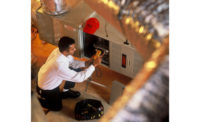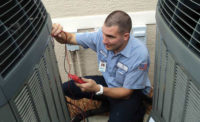Canada Mandates Condensing Furnaces

The 95.1 percent AFUE furnace shown here will qualify for Canada’s new standard, which requires most residential gas furnaces to have a minimum fuel efficiency level of 90 percent AFUE. (Courtesy of Nordyne.)
The day Jan. 1, 2010 will bring many changes to the HVAC industry. As of that date, R-22 will no longer be available in new cooling systems manufactured in the United States or Canada, and our neighbors to the north will have a new national minimum energy performance standard for gas furnaces. After the New Year, gas furnaces manufactured for most Canadian residential applications must have a minimum fuel efficiency level of 90 percent AFUE.
This is a significant jump from the current Canadian minimum standard of 78 percent AFUE for gas furnaces, but the new regulation was not a surprise, as the government has discussed raising minimum furnace efficiency standards for more than 10 years. The reasons given for the new efficiency standard are to improve the environment and reduce greenhouse gases; in addition, the more efficient furnaces will reduce energy bills for consumers.
Many in the industry have been anticipating government mandates of higher efficiency gas furnaces considering the current emphasis on climate change and environmental stewardship. Given these recent changes going into effect up north, it is inevitable that higher efficiency standards for furnaces will soon be coming to the United States as well (see sidebar below).
CHANGE CAN BE GOOD
Warren Heeley, president, Heating, Refrigeration and Air Conditioning Institute of Canada (HRAI), has been involved in the discussions regarding higher furnace efficiency standards for many years. He said HRAI has been opposed to the new standard since these discussions with the government began because of the concern that it would seriously limit consumer choice in the furnace market.“The new standard takes the efficiency range down to a very narrow 5 to 6 percent, so it will become more difficult to differentiate between models of furnaces with the customer,” said Heeley. “And, of course, the current price difference between high- and mid-efficiency furnaces will be eliminated, and this will remove the more economical option for consumers who may not be able to afford the more expensive high-efficiency option. There are also some installations where mid-efficiency furnaces are the best technology to use - for example, in areas where high-efficiency technology does not have the kind of payback that makes sense to the consumer, or in situations where proper venting might be a problem.”
That being said, Heeley said that HRAI members have accepted the new standard, and he thinks most others in the HVAC community are generally supportive of the change. “In the bigger picture of energy conservation, the new efficiency standard is obviously going to be a plus for Canadians. As a matter of fact, the majority of sales in the country now are condensing furnaces. Contractors are selling them, because in most cases, they are a better product for the consumer. But from the perspective of the product itself, our concern has been that it starts to become a commodity. How do you differentiate between products with such a narrow range of efficiency? Hopefully, furnaces will continue to be a broad sales opportunity for the contractor and not become a simple commodity to the consumer.”
Jacques Campeau, owner, Campeau Heating, Sudbury, Ontario, Canada, has not promoted mid-efficiency furnaces for many years, and he believes the new standard will be a positive change for the industry and the environment.
“There is no reason to sell mid-efficiency furnaces. While a mid-efficiency furnace costs less to purchase initially, over the long term, the savings in energy costs for a high-efficiency furnace more than offset the higher initial cost. In addition, homeowners get peace of mind with a new furnace, and most brands offer excellent warranties. For example, we have a 10-year warranty on parts with the Frigidaire products. Most importantly, we are protecting the environment by reducing CO2 emissions.”
While the initial cost of a 90-percent-plus furnace may be higher than mid-efficiency equipment, Campeau does not believe that is a major issue. “In Canada, we have government subsidies that help offset the extra cost of installing more efficient heating systems. For example, Ontario homeowners who upgrade to a 94-percent efficient furnace with a brushless DC motor will receive $1,580 from the Eco Energy program.”

Modulating technology is primarily found in 90-plus-AFUE gas furnace models - such as the York Affinity furnace shown here - which will qualify under Canada’s new efficiency standard for gas furnaces. (Courtesy of Johnson Controls Inc.)
OTHER CHANGES BEING CONSIDERED
Manufacturers also seem unfazed by the impending higher furnace efficiency standard in Canada. “We already produce and sell a complete product offering in condensing furnaces. Canadian requirements can be met today, without any changes to our business,” said Bryan Rocky, product manager II, Indoor Products North America, Johnson Controls Inc. “The change in Canada does not have a direct impact on the U.S. market, as the market in most states that border Canada is already driving the use of condensing furnaces as the standard product.”Matt Lattanzi, director of product and brand management, Nordyne, said the company is anticipating a mix shift in furnace production to condensing furnaces, but it is too early to tell how this will affect the U.S. market. “While it makes a lot of sense for Canada due to their colder climate, the U.S. is more varied and a condensing furnace does not make as much sense in every region.”
Heeley noted that there are other changes in store regarding furnace standards in Canada, as the government is currently pursuing a rating system for the electrical energy consumption of furnaces. “They’re looking at test methods to determine and compare electrical consumption levels, and once that system is in place, I anticipate that they will start talking about how to improve the electrical usage in furnaces.”
Improving the electrical usage in furnaces usually involves the use of an ECM-style motor, which is now almost exclusively used in premium, high-end furnaces, as opposed to the entry-level standard products. The U.S. Department of Energy (DOE) is considering this issue as well, which could be a concern, as the ECM-style motor would definitely increase the initial cost of the furnace to the consumer.
Lattanzi is not a fan of this scenario, noting that if the DOE is considering mandating the use of ECM motors, it would be a mistake. “It’s never wise for a government agency to mandate a means to an end. The DOE should concentrate on developing the appropriate standards and allow the industry to implement the appropriate technologies for achieving the performance requirements. Prescribing the method stifles innovation and handcuffs the industry.”

Nordyne is anticipating a shift in furnace production to condensing furnaces but states that it is too early to tell how the Canada standard will affect the U.S. market. (Courtesy of Nordyne.)
Rocky noted that the industry has to remember that DOE’s main direction is to reduce the total energy consumption of the nation. This means that other factors such as cost impact, technology required, and how to implement those changes are somewhat secondary. “While the DOE does consider economic impacts in their energy efficiency standards requirements, that is not the critical driving factor, and economic impacts may actually be discarded as insignificant in some cases.”
This could definitely be an issue because the added cost of ECM-style motors over a standard motor is significant to the manufacturer, and by the time the product makes it through the distribution chain to the end user, that cost may be many hundred dollars more, said Rocky. “Higher initial costs will drive replacement situations toward more repair than replace for many people. This again reduces the potential energy savings achieved versus what would be expected by this type of legislation.”
While it’s too early to say whether the governments of Canada and the United States will soon regulate electrical energy consumption of furnaces, they are definitely considering this option in their ongoing attempts to reduce power demands across both countries. As for the new minimum energy efficiency standard for gas furnaces that takes effect in Canada at the beginning of the year, Campeau states that it will be “a win-win situation for homeowners and the environment.”
Sidebar: Boost Guidelines
In response to Canada’s new minimum energy efficiency standard for gas furnaces, EPA’s Energy Star program is considering boosting the efficiency requirement for its participating gas furnaces, which has been 90 percent AFUE (or greater) since 1995.“The Canadians are raising their efficiency standard for gas furnaces, so we need to make a decision to change our specification rather rapidly,” said Andrew Fanara, U.S. EPA, Energy Star Program. “We were waiting for the recent announcement by DOE regarding the need for a more accurate regionally based specification, and now that’s been made, we can move forward with the appropriate changes and timing for the specification.”
While it has not yet been decided whether Energy Star will offer regional guidelines that are in line with DOE’s specification, it is certainly not out of the question. “We haven’t made the decision yet, but presumably we would go to a regional model,” said Fanara. “However, the timing of DOE’s standard change is in question, and if it doesn’t happen for a few years, then we have to decide whether or not to move ahead with our current specification or move rapidly to some form of a regional specification.”
Another reason why boosting the efficiency requirement for gas furnaces is under consideration at Energy Star is due to the program’s increasing popularity. “In 2008, the marketshare for Energy Star furnaces was about 43 percent, so it’s obvious we need to update that specification,” said Fanara. “That, combined with the standard change in Canada, and the fact that our partners have a strong interest in high efficiency products means we have to continue to up the ante - where it makes cost-effective sense.”
Fanara stated that the cost-effective angle is why DOE recognized the need to create a regional standard for HVAC equipment, because a furnace that is cost effective in Minnesota may not make the same economic sense as in Arizona. “Things are definitely lining up for us to rapidly make the change on furnace efficiencies. Once we decide where we want to go, we will meet with our stakeholders, so they can weigh-in with their viewpoints.”
Energy Star has no timeline in place for raising the efficiency requirements for furnaces participating in its program, however, Fanara believes that a new specification may be ready sometime next year.
Publication date: 11/16/2009
DOE requirements
December 6, 2009
I think that these requirements are long past due I'm glad there is work being initiated in this area.It should be a no brainer as to making reigonal standards of compliance. Good thinking.
efficient furnaces? maybe for Carrier's bottom line
February 17, 2010
BS Ken, wait until you start fixing these POS furnaces. My Carrier has broken 3 times in 4 years (just after warranty of course). In each instance the part was over $1000 !!!!! completely eliminated the BS argument of savings. Each those obscenely priced parts and its supply chain and installation carries a big carbon shadow as well. Don't take choice away from consumers, you'll regret it
mad in Canada







